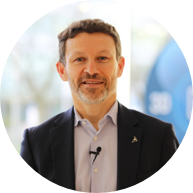In the coming days, the Paris Air Show is going to open for the 54th edition.
Once again it will bring together all players in Aerospace and Defense Industry the latest innovations. Back to Olivier Sappin’s interview conducted by Accenture on how device shadow technology can support innovation and sustainability.
How can virtual twin technology support innovation and sustainability?
Olivier Sappin: “There is not any companies that cannot redefine its purpose. Looking at sustainability and sustainability means many things. It means I need to make sure that in terms of emission, in terms of impact on the planet, every single aircraft, helicopters, new eVTOL solution would have a better impact in the complete lifecycle. In fact, 80% of the impact of both products will be defined in the very early stage of the product. So, the more you can anticipate all this impact upfront, the better it is in terms of cost in terms of time to market. Therefore, this is why with CATIA in the 3DEXPERIENCE platform we really work with many innovative players in the aerospace sector and space sector, but also a traditional audience to work in the very early concept stage and to be able to really assess the complete lifecycle assessment of the full aircraft. It is new in our offering. We just introduced virtual twin last year and it is very promising for all actors in The Aerospace and defense segments.”
What is model-based approach?
Olivier Sappin: “You know, a model based is something that has been invented a while ago when we were switching from 2D to 3D. Now, it is not only about mechanical engineering it is about systems because you need to consider a mechanical but also Electronics, electrical software. We need to empower engineers to design both systems and even system of system from mission to certification. For this, you are right; we need the model-based approach as model-based requirement, model-based system specification, and model-based architecture in order to have a complete 3D Master model based approach, along the complete life cycle.”
Is there a way to reverse-engineer existing fleets?
Olivier Sappin: “Absolutely, there is a way, and you know we have several programs. One of them is very interesting. We are doing with NIAR, the National Institute of Aviation research in Wichita in Kansas U.S. After that, we are doing a very important program called digital twin. We take the planes that has been designed in 2D and we do reverse engineering to take them in 3D. The goal is really to make the aircraft to fly in the virtual environment in order to fully validate the full mission of their aircraft in the digital world. Not only from a mechanical standpoint getting the 2D drawings and getting them in 3D, but also re architects the system. The aim is to make sure that then you can if you want to renovate their aircraft or if you want to order a part that you cannot do anymore because you just get drawings. Then you get a second life for the aircraft.”
How can CATIA improve performance?
Olivier Sappin: “You make a good point. Performance as a matter of fact you know when we came from CATIA V5 to CATIA 3DEXPERIENCE. On our platform the goal was really also to break the silos between modeling and simulation. We want to do what we call MODSIM. The goal is to give the capacity for every engineer’s right from the concept stage. If they start to design, they need immediate real-time feedbacks about what it will be in terms of performance for noise, aerodynamics, comfort to make sure that they can design right the first time.”
How do you see things evolving with the rise of the Metaverse?
Olivier Sappin: “Who can be better positioned to talk about Metaverse? I mean, this is what we do for the last 40 years. We have been working on the first digital aircraft with the 777 with Boeing. Since, we did the first complete lifecycle of a vehicle with Toyota in 2000. Now, we do a digital twin with NIAR, but also vertical Aerospace. Of course in parallels, we work with the traditional big company like Boeing and Airbus. Therefore, for us, yes, the virtual twin offers a complete new field of innovation for all the actors. It open new possibilities to realize brand new innovation, sustainable innovation, sustainable experience. When I look at all these innovations on the actual, it is very fascinating to see how far we can go using that.”
What are your ambitions, regarding virtual twin, for the future of the industry?
Olivier Sappin: “What is fascinating at your show is that you see all the different companies showing their Innovations. Here, most of them are working with us with our new flagship Solutions 3DEXPERIENCE platform with CATIA. There are three fundamental things that we want to do in terms of priorities. One, is as I said is sustainable Innovation. Making sure that the heart of what we do, we can empower Engineers to check at any point of time in the lifecycle what will be the impact, what will be the lifecycle assessment of their components product system. The second thing is systems. It is no longer about mechanical; it is a lot of electronics, electrical and software. Therefore, the system of system approach for us is fundamental. It is a new CATIA. Moreover, the last but not least, is breaking the silos between modeling and simulation. Giving the capacity for every design engineers to see their model and the performance to design right the first time thanks to virtual prototyping.”

